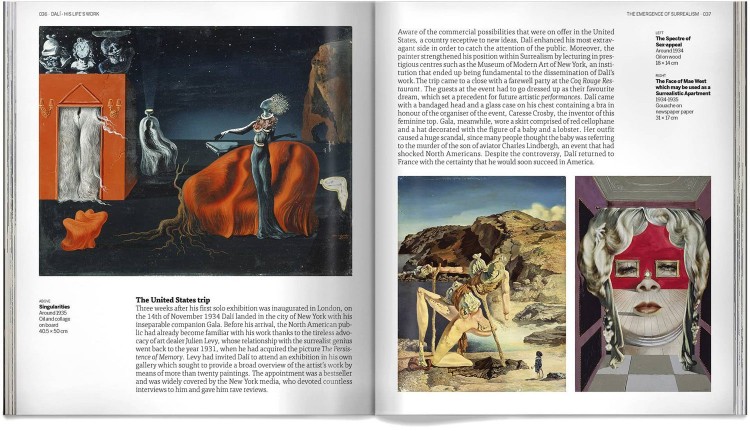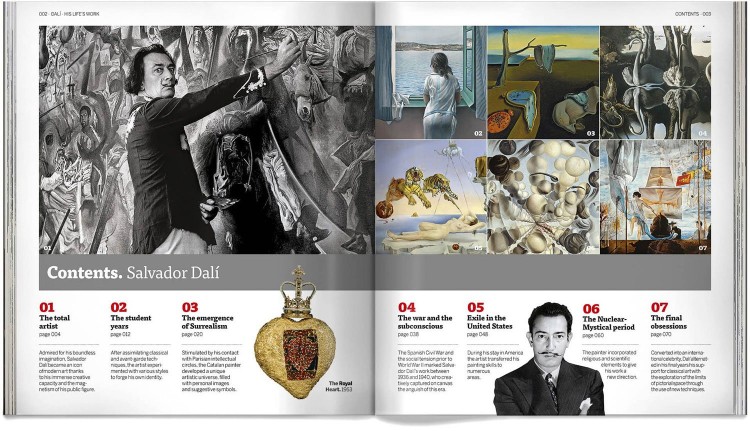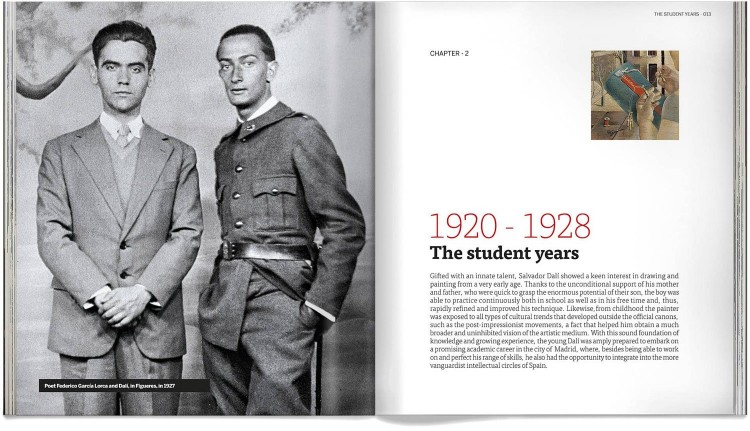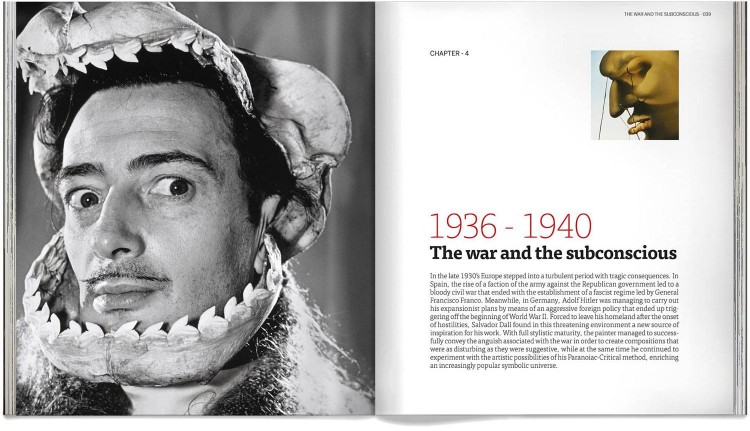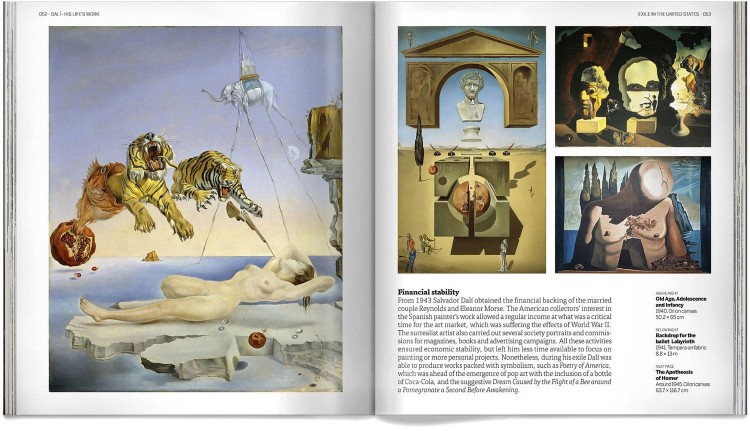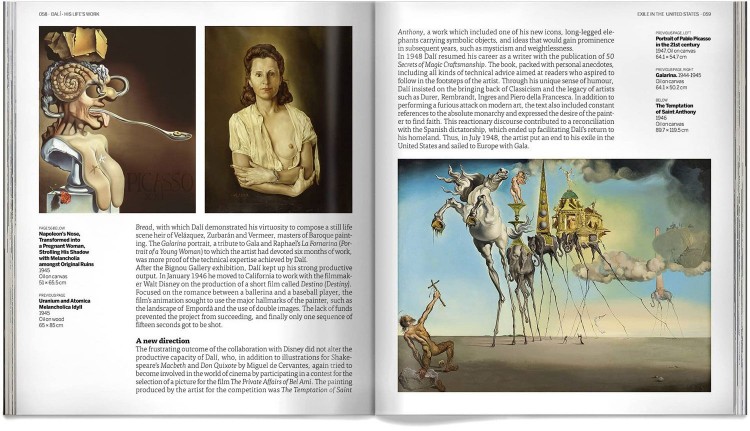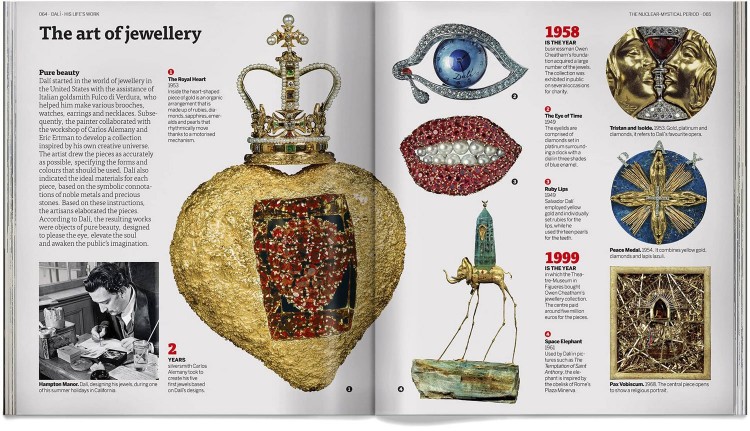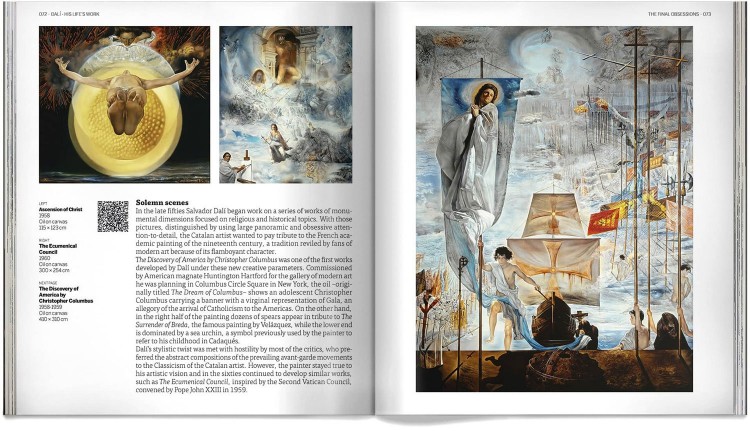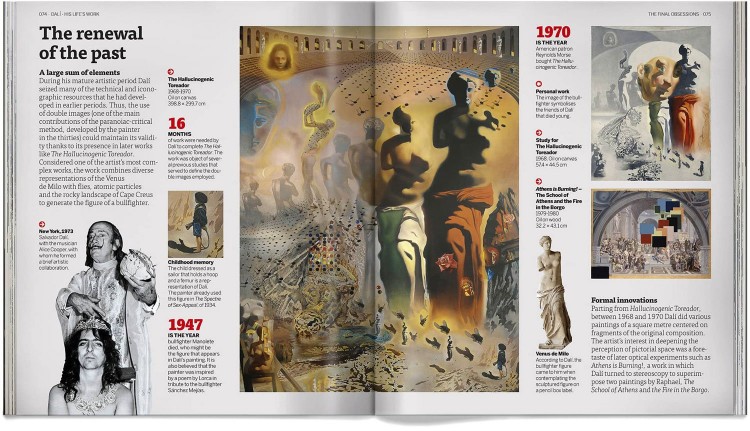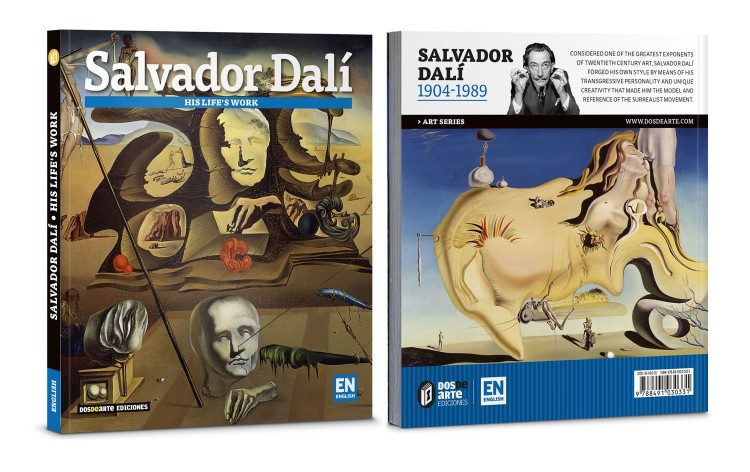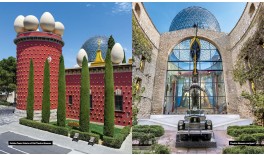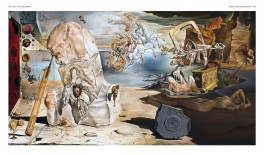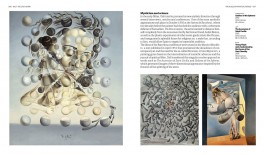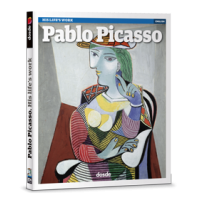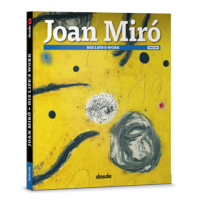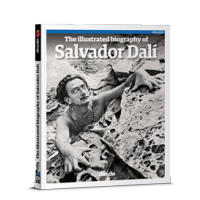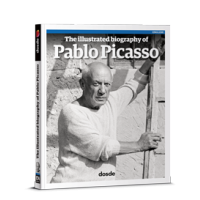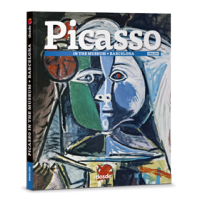Salvador Dalí
His life's work
RETURN
About the book Salvador Dalí, his life's work
This book on Salvador Dalí published by Dosde offers a detailed view of the most important works of the surrealist artist, setting them in their historical context and analysing their influences. Through its pages, the reader will be able to delve into the significance of Dalí's paintings, while at the same time find out more details about the life of one the greatest geniuses of all time.
The book Dalí, his life's work has been carried out in order to present the graphical and informative content in a very visual and detailed way. Thus the content has been organised chronologically, relating the painter's work with his life, his influences and the historical context, as well as providing an abundance of fascinating facts about Dalí. The book contains a wealth of excellent quality pictures and the highest possible colour accuracy, which guarantees the printed colour is practically the same as the original work.
This book has been validated by the Fundación Gala Salvador Dalí, the institution that manages the artist's heritage. This means that it is a thorough and demanding work and that it has passed the controls of the organization that knows Salvador Dalí the best. A characteristic that also distinguishes Dalí's biography published by Dosde.
The book Dalí, his life's work has been carried out in order to present the graphical and informative content in a very visual and detailed way. Thus the content has been organised chronologically, relating the painter's work with his life, his influences and the historical context, as well as providing an abundance of fascinating facts about Dalí. The book contains a wealth of excellent quality pictures and the highest possible colour accuracy, which guarantees the printed colour is practically the same as the original work.
This book has been validated by the Fundación Gala Salvador Dalí, the institution that manages the artist's heritage. This means that it is a thorough and demanding work and that it has passed the controls of the organization that knows Salvador Dalí the best. A characteristic that also distinguishes Dalí's biography published by Dosde.
Visual Edition
Salvador Dalí
It includes exclusive digital content
Made with environmentally friendly paper
Official licensed product
Multilanguage: Available in 8 languages
About the book Salvador Dalí, his life's work
This book on Salvador Dalí published by Dosde offers a detailed view of the most important works of the surrealist artist, setting them in their historical context and analysing their influences. Through its pages, the reader will be able to delve into the significance of Dalí's paintings, while at the same time find out more details about the life of one the greatest geniuses of all time.
The book Dalí, his life's work has been carried out in order to present the graphical and informative content in a very visual and detailed way. Thus the content has been organised chronologically, relating the painter's work with his life, his influences and the historical context, as well as providing an abundance of fascinating facts about Dalí. The book contains a wealth of excellent quality pictures and the highest possible colour accuracy, which guarantees the printed colour is practically the same as the original work.
This book has been validated by the Fundación Gala Salvador Dalí, the institution that manages the artist's heritage. This means that it is a thorough and demanding work and that it has passed the controls of the organization that knows Salvador Dalí the best. A characteristic that also distinguishes Dalí's biography published by Dosde.
The book Dalí, his life's work has been carried out in order to present the graphical and informative content in a very visual and detailed way. Thus the content has been organised chronologically, relating the painter's work with his life, his influences and the historical context, as well as providing an abundance of fascinating facts about Dalí. The book contains a wealth of excellent quality pictures and the highest possible colour accuracy, which guarantees the printed colour is practically the same as the original work.
This book has been validated by the Fundación Gala Salvador Dalí, the institution that manages the artist's heritage. This means that it is a thorough and demanding work and that it has passed the controls of the organization that knows Salvador Dalí the best. A characteristic that also distinguishes Dalí's biography published by Dosde.
Videos Salvador Dalí
No reviews yet.
Additional Information
- Additional Information
- Subtitle: His life's work
- Weight (g): 350
- Binding: Paperback
- Size (cm): 19,5 x 22,5
- Author: Dosde
- Pages: 0
- Edition: Visual Edition
The works of Salvador Dalí
Throughout his career, Salvador Dalí used painting in order to reflect the events that happened during his life, which meant his works gained in depth and acquired multiple interpretations.
The Catalan artist developed a wide range of symbolic images, often indecipherable, to refer to his family and his childhood traumas, which became an inexhaustible source of inspiration. Dalí's wife, Gala, was another key part of the creative universe of a painter specialised in exploring the innermost recesses of the human being.
From 1927, Dalí approached the tenets of Surrealism, an artistic and literary movement heir of Dadaism that advocated the validity of the dream world and irrational impulses.
Although still reluctant to be classed as a Surrealist, Dalí adopted many of the features characteristic of this movement in the pictures carried out during this period, recreating oneiric-like spaces populated by strange figures without any apparent connection.
In Dalí's paintings such as Honey is Sweeter than Blood, the strong personality of the artist was reflected in the use of a particularly aggressive iconography.
In 1929, after spending two months in Paris, Dalí moved to Cadaqués to plunge into a particularly fertile creative period.
Added to the repeated readings of the writings of André Breton, the frequent meetings he had had with various French intellectuals accelerated his evolution into a style that was fully based on surrealist postulates, which gave great evocative power to Dalí's paintings during this period.
Incorporating the theories of Sigmund Freud in the Interpretation of Dreams, the artist began to work on various hallucinatory scenes that, despite their apparent irrationality, were the result of painstaking and time-consuming work, based on the systematisation of ideas and much more intimate images.
Presided over by the self-portrait of the painter –inspired by a rock in Cape Creus– the canvas referred to ongoing tensions between sexual desire and the satisfaction of pleasure, while alluding to his flight from the family nest, who was strongly opposed to Dalí’s relationship with Gala.
The stunning landscape of Portlligat was the setting for The Persistence of Memory, a work in which Dalí expressed the anguish of the human race to control time by the means of three melting clocks that, according to the painter, were inspired by Camembert cheese. First exhibited in 1931 at the Pierre Colle Art Gallery, Dalí's painting fascinated the public and raised all kinds of interpretations, such as those that related the clocks to Albert Einstein's Theory of Relativity.
Made up of seemingly random combinations of different everyday objects, these pieces of striking design intended to overcome the traditional concept of sculpture, since in their elaboration rational criteria was ignored.
Although the surrealist objects had no practical uses, Dalí nonetheless tried to sell some of his creations. However, difficulties encountered in the manufacturing processes meant that the artist’s plans couldn’t come to fruition. Despite this, these pieces over time have converted into some of Dalí's most iconic works, as well as symbols of the painter's tireless imagination.
Nonetheless, during his exile Dalí was able to produce works packed with symbolism, such as Poetry of America, which was ahead of the emergence of Pop Art with the inclusion of a bottle of Coca-Cola, and the suggestive Dream Caused by the Flight of a Bee around a Pomegranate a Second Before Awakening, which forms part of the collection of the Museo Nacional Thyssen-Bornemisza.
Dali started his Nuclear-Mystical period with the painting The Madonna of Portlligat, a piece which he had already begun working on when in exile in the United States and two versions were made, the first one completed in Portlligat in the summer of 1949. Dalí's painting obtained the approval of Pope Pius XII during a private hearing held in Rome in November of that year.
After obtaining the admiration of the highest hierarch in the Catholic Church, the painter felt entitled to carry on working on that particular interpretation of Christian iconography and religious sentiment. In the following years, this creative path led to landmarks like Christ of Saint John of the Cross, a crucifixion scene in which the Catalan artist used his knowledge of baroque perspective and chiaroscuro.
In the late fifties Dalí began a series of works of monumental dimensions focused on religious and historical themes. With those paintings, Dalí wanted to pay tribute to the French academic painting of the nineteenth century, a tradition reviled by fans of modern art because of its flamboyant character.
The Discovery of America by Christopher Columbus was one of the first Dalí's works under these new creative parameters. Commissioned by American magnate Huntington Hartford for the gallery of modern art he was planning in Columbus Circle Square in New York, the painting shows an adolescent Christopher Columbus carrying a banner with a virginal representation of Gala, an allegory of the arrival of Catholicism to the Americas.
From the 1970’s Dalí reduced his painting activity, but not his desire to surprise the public. Inspired by the work of baroque portrait painter Gerard Dou, the artist began studying stereoscopy, a technique that allowed the creation of a relief effect by using two almost identical pictures and a mirror system.
The painter alternated this method with holography, a recent invention that used lasers to generate three-dimensional images. These experiments demonstrated the untiring curiosity of Dalí, an artist concerned until his final days about exploring the limits of painting.
The Catalan artist developed a wide range of symbolic images, often indecipherable, to refer to his family and his childhood traumas, which became an inexhaustible source of inspiration. Dalí's wife, Gala, was another key part of the creative universe of a painter specialised in exploring the innermost recesses of the human being.
Surrealism and Dalí
From 1927, Dalí approached the tenets of Surrealism, an artistic and literary movement heir of Dadaism that advocated the validity of the dream world and irrational impulses.Although still reluctant to be classed as a Surrealist, Dalí adopted many of the features characteristic of this movement in the pictures carried out during this period, recreating oneiric-like spaces populated by strange figures without any apparent connection.
In Dalí's paintings such as Honey is Sweeter than Blood, the strong personality of the artist was reflected in the use of a particularly aggressive iconography.
In 1929, after spending two months in Paris, Dalí moved to Cadaqués to plunge into a particularly fertile creative period.
Added to the repeated readings of the writings of André Breton, the frequent meetings he had had with various French intellectuals accelerated his evolution into a style that was fully based on surrealist postulates, which gave great evocative power to Dalí's paintings during this period.
Incorporating the theories of Sigmund Freud in the Interpretation of Dreams, the artist began to work on various hallucinatory scenes that, despite their apparent irrationality, were the result of painstaking and time-consuming work, based on the systematisation of ideas and much more intimate images.
The first famous paintings of Salvador Dalí
In the summer of 1929, Dalí and Gala began a romantic relationship. Under the influence of his new partner, who helped him to pyschologically break free, the artist embarked on The Great Masturbator, which is currently in the Museo Nacional Centro de Arte Reina Sofía.Presided over by the self-portrait of the painter –inspired by a rock in Cape Creus– the canvas referred to ongoing tensions between sexual desire and the satisfaction of pleasure, while alluding to his flight from the family nest, who was strongly opposed to Dalí’s relationship with Gala.
The stunning landscape of Portlligat was the setting for The Persistence of Memory, a work in which Dalí expressed the anguish of the human race to control time by the means of three melting clocks that, according to the painter, were inspired by Camembert cheese. First exhibited in 1931 at the Pierre Colle Art Gallery, Dalí's painting fascinated the public and raised all kinds of interpretations, such as those that related the clocks to Albert Einstein's Theory of Relativity.
Dalí's surrealist objects
From 1931 Salvador Dalí alternated painting with the creation of surrealist objects, a practice that had its precedent in the Dadaist constructions of French artist Marcel Duchamp and which was promoted by André Breton in order to transfer the ideas of the subconscious to the material world.Made up of seemingly random combinations of different everyday objects, these pieces of striking design intended to overcome the traditional concept of sculpture, since in their elaboration rational criteria was ignored.
Although the surrealist objects had no practical uses, Dalí nonetheless tried to sell some of his creations. However, difficulties encountered in the manufacturing processes meant that the artist’s plans couldn’t come to fruition. Despite this, these pieces over time have converted into some of Dalí's most iconic works, as well as symbols of the painter's tireless imagination.
The American era
In August 1940, two months after German troops paraded through the centre of Paris, Dalí and Gala departed from Lisbon to the United States, where they would stay for the next eight years. During this period, Dalí carried out several society portraits and commissions for magazines, books and advertising campaigns. The works of Dalí which were more commercial guaranteed the painter's financial stability in some critical years for the art market.Nonetheless, during his exile Dalí was able to produce works packed with symbolism, such as Poetry of America, which was ahead of the emergence of Pop Art with the inclusion of a bottle of Coca-Cola, and the suggestive Dream Caused by the Flight of a Bee around a Pomegranate a Second Before Awakening, which forms part of the collection of the Museo Nacional Thyssen-Bornemisza.
Dalí's Nuclear-Mystical style
Dali started his Nuclear-Mystical period with the painting The Madonna of Portlligat, a piece which he had already begun working on when in exile in the United States and two versions were made, the first one completed in Portlligat in the summer of 1949. Dalí's painting obtained the approval of Pope Pius XII during a private hearing held in Rome in November of that year.After obtaining the admiration of the highest hierarch in the Catholic Church, the painter felt entitled to carry on working on that particular interpretation of Christian iconography and religious sentiment. In the following years, this creative path led to landmarks like Christ of Saint John of the Cross, a crucifixion scene in which the Catalan artist used his knowledge of baroque perspective and chiaroscuro.
Dalí's final paintings
In the late fifties Dalí began a series of works of monumental dimensions focused on religious and historical themes. With those paintings, Dalí wanted to pay tribute to the French academic painting of the nineteenth century, a tradition reviled by fans of modern art because of its flamboyant character.The Discovery of America by Christopher Columbus was one of the first Dalí's works under these new creative parameters. Commissioned by American magnate Huntington Hartford for the gallery of modern art he was planning in Columbus Circle Square in New York, the painting shows an adolescent Christopher Columbus carrying a banner with a virginal representation of Gala, an allegory of the arrival of Catholicism to the Americas.
From the 1970’s Dalí reduced his painting activity, but not his desire to surprise the public. Inspired by the work of baroque portrait painter Gerard Dou, the artist began studying stereoscopy, a technique that allowed the creation of a relief effect by using two almost identical pictures and a mirror system.
The painter alternated this method with holography, a recent invention that used lasers to generate three-dimensional images. These experiments demonstrated the untiring curiosity of Dalí, an artist concerned until his final days about exploring the limits of painting.

